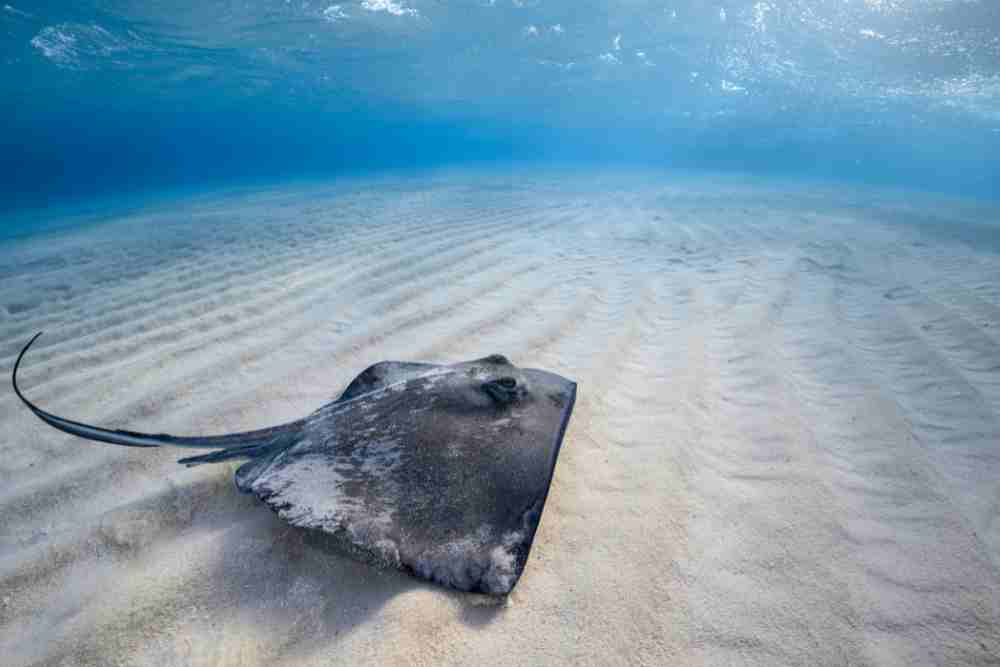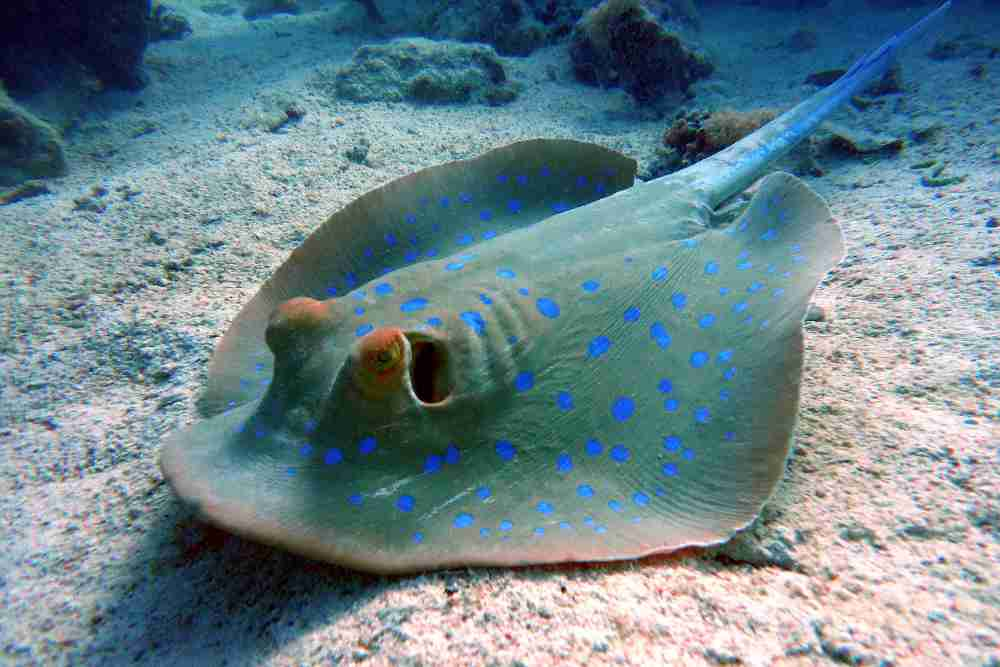Stingrays are fascinating creatures that inhabit our oceans and have intrigued scientists and nature enthusiasts alike. With their flat bodies, wing-like fins, and long tails armed with venomous spines, these graceful beings have captivated our curiosity for centuries.
While we may be familiar with their distinct appearance and association with Steve Irwin’s tragic accident, there is much more to stingrays than meets the eye.
In this article, we will delve into ten surprising facts about stingrays that will astound and amaze you.
From their incredible biological adaptations to their unique behaviors, get ready to discover a whole new world beneath the waves as we unravel the mysteries of these enigmatic creatures.

10 Surprising Facts About Stingray
1. Stingrays Are Related to Sharks

Stingrays are cartilaginous fish (They have no bones in their body) and belong to the same class as sharks, called Chondrichthyes. This means that they have a skeleton made of cartilage, rather than bone.
Their skeleton is made of flexible cartilage, similar to our ears and nose. Both have similar skin structures called dermal denticles. Their cartilaginous skeleton makes them flexible while swimming.
Both have special sensors to detect signals from their surroundings while hunting and a streamlined body for efficient swimming.
2. Most Primitive Ocean Animal
Stingrays have been around since the Lower Jurassic period, over 150 million years ago. Fossils of stingrays are scarce because their cartilaginous skeletons leave little evidence after they die.
There are 220 different identified species of stingrays, spread across the world’s ranging from the large “short-tailed stingrays” to smaller varieties like the “spotted stingray” and “yellow stingray.” and found in oceans, seas, lakes, and rivers, with each species having its own unique characteristics.
Stingrays have been inhabiting Earth’s waters for millions of years, since the time of dinosaurs, and have evolved into hundreds of different species, each with unique characteristics, size, and habits.
3. Like Warm and Shallow Water

Stingrays are a diverse group of fish with flattened bodies and can be found in oceans in tropical and subtropical areas worldwide. They prefer warm and shallow waters and spend most of their time hidden on the ocean floor.
There are over 75 different species of stingrays found throughout the world, including closely related River rays that live in freshwater rivers.
There are more than 200 species of stingrays, varying in shapes and sizes. Some species are small enough to fit in the palm of a hand, while others can grow several feet across.
Each species of stingray has unique characteristics and adaptations that help them survive in their respective environments.
Stingrays often live solitary lives and come together for breeding and migration. Large groups of migrating rays are called a “Fever” and can reach up to 10,000 individuals.
4. Giant Size and Heavy Weight
There are 60 different species of stingrays, some of which are threatened. The largest stingrays can reach up to 6.5 feet in length and weigh up to 790 pounds.
The short-tail stingray is the largest species of stingray, with widths reaching up to 7 feet and lengths of fourteen feet, weighing up to 350 kilograms.
The Southern Stingray is one of approximately 90 species of stingrays. Its huge fins can reach up to six feet across, making it resemble a prehistoric bird.
Stingrays swim in a distinct manner, undulating their bodies up and down, which resembles the flapping of bird wings. They can migrate up to 850 kilometers at a consistent speed.
Female Stingrays are larger than males and have a longer lifespan, living for an average of 15 to 22 years, while males live for 5 to 7 years on average.
5. Flying Through The Water

Stingrays swim by moving their flippers up and down, similar to the wing movements of birds, leading to the nickname “flying through the water.”
They have broad fins running the length of their bodies, giving them a flat, round shape for swimming.
Stingrays have a distinct flattened body shape with wide pectoral fins, allowing them to glide gracefully through the water, similar to a bird in flight.
They have eyes on the top side of their body, and their mouth and gills are underneath, making their electromagnetic sense useful in darker depths or murky rivers.
Stingrays have five to seven pairs of gills on the underside of their bodies, allowing them to extract oxygen from the water and stay underwater for extended periods.
They have spiracles near their eyes that help pump water into their gills so they can breathe even when stationary.
6. Natural Navigation Ability
Stingrays possess natural navigation abilities and can detect existing geomagnetic fields, using them as reference points for their natural navigation systems.
They have electro-sensors that help them detect electronic charges released by their prey.
Stingrays have eyes located on the top of their heads, but they primarily use electro sensors to detect electrical charges emitted by their prey.
Their mouths are located on the bottom side of their bodies, and they use powerful jaws to crush and eat clams, shrimps, and mussels.
Stingrays have powerful jaws capable of crushing clam shells and other prey. Their jaws are made of cartilage and have a layered structure to increase strength while remaining lightweight.
7. Ovoviviparous in Nature

Stingrays are “ovoviviparous,” meaning they give birth to live young that hatch from eggs held within the body.
That meaning they keep their eggs inside their bodies where they develop and hatch, and then the Stingray gives live birth.
They exhibit a unique reproductive strategy known as aplacental viviparity, where female stingrays give birth to live young. The embryos develop inside the mother’s body and are born as fully formed miniature stingrays.
Baby stingrays have a jelly-like coating covering their barb to protect the mother during birth.
Female stingrays give birth to between 5 and 15 fully developed baby stingrays. The newborns look like miniature versions of the adults and learn to take care of themselves from birth.
They give birth to two to six fully developed young each year, and baby stingrays are born looking like miniature versions of adults.
8. Stingrays Have a Venomous Spine

Stingrays possess a stinger, a barbed spine located at the base of their tail, which is used for self-defense when they feel threatened. It’s important to be cautious and give them space when swimming in the ocean.
Most species of stingrays have a venomous spine located near the base of their tail. This spine is used for defense and can cause a painful injury to humans.
The venom in their tails are usually non-fatal to humans, with exceptions near critical areas like the heart.
Ancient Greek dentists used stingray venom as an anesthetic, and people in areas where stingrays are found used their spines to create weapons like daggers. The venom remains deadly even after extraction from a dead stingray.
The venomous spine is located near the base of their powerful whip-like tail. While not aggressive, stingrays can use their spine for defense, and a large ray can cause serious and painful wounds.
The unique method of defense with a long barb made of keratin (the same material as human nails and hair), covered in venomous skin. They swing their barbs to protect themselves from potential threats.
9. Camouflage Nature

Stingrays are excellent at camouflage. They are usually modeled light gray to dark brown, which allows them to blend in with the sandy ocean floor where they lie in wait for unsuspecting prey.
Stingrays bury themselves under the sand to sleep and are carnivorous animals, feeding on crustaceans, small fish, and worms.
Stingrays are most dangerous when lying camouflaged in the sand. They move slowly and forage for invertebrates hidden on the sea floor.
Their eyes are on top of their heads, and their mouth and nostrils are below, so they rely on smell, touch, and sensing the electrical field of their prey to find food.
Stingrays have a color that usually matches the mud or sand where they hide. Their mouth is on the underside of their body, along with their nostrils and gill slits, while their eyes are on top.
10. Popular Aquariums and Zoos Animal

Many species of stingrays are popular in aquariums and zoos, where visitors can observe them up close. Some facilities even allow visitors to touch and feed the stingrays.
Stingrays are unique creatures that live in oceans worldwide, known for their chic and graceful swimming style.
Studying stingrays helps us appreciate the wonders of marine life and their survival strategies in aquatic environments..
1 thought on “10 Surprising Facts About Stingrays That You Never Learn”
Comments are closed.